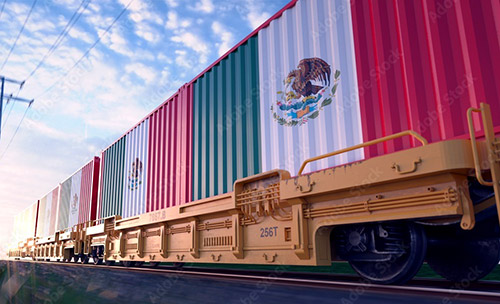Nearshoring — North America’s Next Factory
Its strong maquiladora program, skilled labor, and favorable geographic location have made Mexico a top choice for nearshoring to the U.S. market.
Q2 2023

When I look back on the last two and half years, I can’t help but think how this phenomenon has impacted Mexico’s economy, which I have personally experienced with at least 50 percent of my projects as a consultant in a public commercial real estate firm. There are several reasons why foreign investors are considering Mexico as a viable option, both in general and specifically in the context of nearshoring (or ally-shoring) and I will cover some of them in this article.
The Maquiladora Program
Besides its neighborship to the U.S., another element that makes Mexico a top choice for nearshoring is the maquiladora or IMMEX program. According to the Mexican Ministry of Economic Affairs, the maquiladora program allows the temporary import of goods that are used in an industrial process or service to produce, transform, or repair foreign goods for subsequent export or provision of export services without the payment of general import tax, value-added tax and, where appropriate, countervailing duties.
This program was originally implemented by companies operating mainly in the electronics and textile industries, carrying out simple assembly operations by low-skilled workers. We are not only talking about U.S. companies but also those from other countries such as Japan, Germany, Korea, and China; this technically falls under the nearshoring category as these investments are primarily driven by a marketseeking objective. Currently, the companies supported by those programs jointly represent 85 percent of Mexico’s manufactured exports.
Besides its neighborship to the U.S., another element that makes Mexico a top choice for nearshoring is the maquiladora or IMMEX program. Available Skilled Labor
Mexico’s proximity to the U.S. and its maquiladora program are undoubtedly excellent attributes to attract foreign investment; yet one of the main concerns I see with my clients is finding qualified labor. However, as a manufacturing based-economy, Mexico’s labor has risen above these concerns and revealed to companies that there is outstanding skilled labor in Mexico. A considerable pool of skilled workers, particularly relevant to maquiladora operations, has been developed over 50 years. This has resulted in a large and diverse workforce with different levels of expertise, all trained in the maquiladora work culture and international standards.
Furthermore, Mexico has a young population with an average age of 29 years, according to INEGI, that will take advantage of the robust system of higher and technological education, along with a vast network of public and private research centers that continually contribute to the development of qualified labor in science and innovation. In the last 10 years, Mexico has seen significant growth in STEM education and graduates an average of 130,000 engineers and technicians annually.
Reducing Supply Chain Risks
Logistics chains reinforce the idea that Mexico’s proximity to the United States is a significant factor that contributes to the country’s appeal for foreign investment. Transportation of raw materials, components, and final products between both countries is mainly by truck — no need to use containers and seaports.
I lived in China for seven years, and I was part of the logistics world there, as a general manager of a Mexican freight forwarder. In early 2020, I was still in Shanghai handling the shipments for my Mexican clients, and I saw the great supply chain disruption happening in front of my eyes, causing a huge turmoil for many companies whose biggest market is the United States. There is no doubt the pandemic showed how vulnerable all shipping is, and now businesses are looking for better alternatives to serve their clients. Mexico appears to be a great choice to accomplish this, relying on its strong logistics network with more than 25 commercial border ports of entry and eight railroad crossing points from Tijuana to Matamoros, 117 seaports, 64 international airports, 27,000 km of railways, and 172,000 km of highways. In addition, Mexico has much lower freight costs per cubic meter compared to China, according to Global Value Chains Disruptions.
Mexico has a young population with an average age of 29 years, according to INEGI, that will take advantage of the robust system of higher and technological education. Another benefit of nearshoring in Mexico and utilizing its logistics chains is the assistance it provides to companies in fulfilling their corporate social responsibility and sustainability objectives. Companies are becoming more concerned about the ecological and social impact of the firms they engage with, and nearshoring provides several advantages. For instance, reduced transportation times result in lower carbon footprints and lower supply chain disruption risks. Furthermore, having manufacturing facilities located closer to the parent company and in a comparable time zone enhances communication and responsiveness, while also allowing for greater transparency and the capacity to verify suppliers and ensure equitable working conditions.
On the other hand, Mexico does face challenges when it comes to utilities. According to Enrique R. Portillo, executive director for Industrial Services at Cushman & Wakefield Mexico, power is a big issue in the entire country. He highly recommends companies coming to Mexico avoid the temptation to buy a greenfield or piece of land without the zoning and infrastructure in place for industrial activities, even if it is offered at a very good price and is in a good location. If properties don’t have the supporting infrastructure — i.e., power, water, natural gas, fiber optics, sewage treatment, etc. — Portillo advises companies to try to avoid these types of properties because they will be investing a lot of time and additional resources to make the land work; additional time and cost can make their project become unfeasible or delay the start of its operation.
To fully progress on nearshoring investments, Mexico needs to ensure the prompt development of its electricity sector to provide access to the grid and the necessary energy supply for industry. The need to shift to clean energy has been emphasized due to the effects of the climate crisis. Many major multinational companies, as well as countries and industrial sectors worldwide, are setting ambitious targets to reduce greenhouse gas emissions. As a result, there is a growing demand for renewable energy to meet the increasing energy requirements of industries globally, including those in Mexico.
In Sum
The COVID-19 pandemic has brought significant changes to the world economy, particularly in the manufacturing sector. This has highlighted the importance of proximity to the market, the availability of a skilled labor force, and reliable logistics networks, making nearshoring an attractive option for companies looking to secure their operations.
Logistics chains reinforce the idea that Mexico's proximity to the United States is a significant factor that contributes to the country's appeal for foreign investment. Mexico, with its strong maquiladora program, skilled labor, and favorable geographic location, has become a top choice for nearshoring, offering competitive advantages that can help companies navigate the challenges of the post-pandemic world. However, the challenges regarding utilities and power supply should not be overlooked, and investors should carefully consider infrastructure before purchasing land for industrial activities.
As the global economy continues to recover, it is likely that more companies will consider nearshoring as a long-term strategy to build resilient and agile supply chains that can adapt to future disruptions, which leads me to believe Mexico is North America’s next factory.
Project Announcements
Australia-Based Aquatic Leisure Technologies Group Plans Opp, Alabama, Manufacturing Operations
12/11/2025
Teradyne Plans Wixom, Michigan, Robotics Operations
12/11/2025
Robinson Plans Altoona, Iowa, Manufacturing Operations
12/11/2025
BioTouch Expands Columbus, Georgia, Operations
12/11/2025
Natrion Plans Erie County, New York, Battery Components Operations
12/11/2025
Czech-Based GZ PrintPak Expands Mount Pleasant, Wisconsin, Manufacturing Operations
12/11/2025
Most Read
-
The Workforce Bottleneck in America’s Manufacturing Revival
Q4 2025
-
Rethinking Local Governments Through Consolidation and Choice
Q3 2025
-
First Person: Filter King’s Expansion Playbook
Q3 2025
-
Lead with Facts, Land the Deal
Q3 2025
-
How Canada Stays Competitive
Q3 2025
-
Investors Seek Shelter in Food-Focused Real Estate
Q3 2025
-
America’s Aerospace Reboot
Q3 2025

